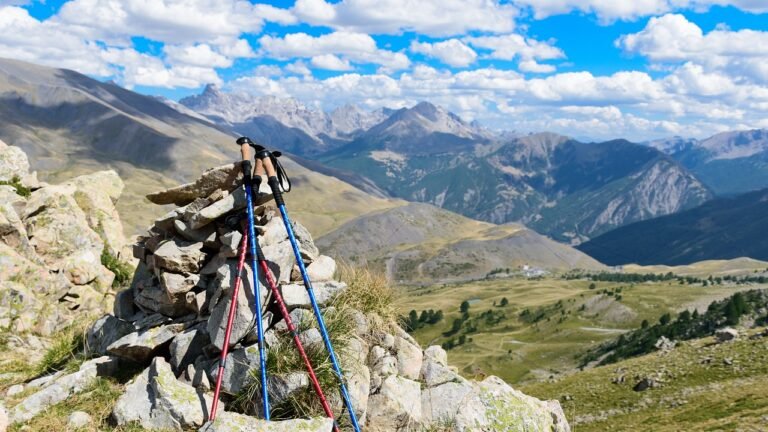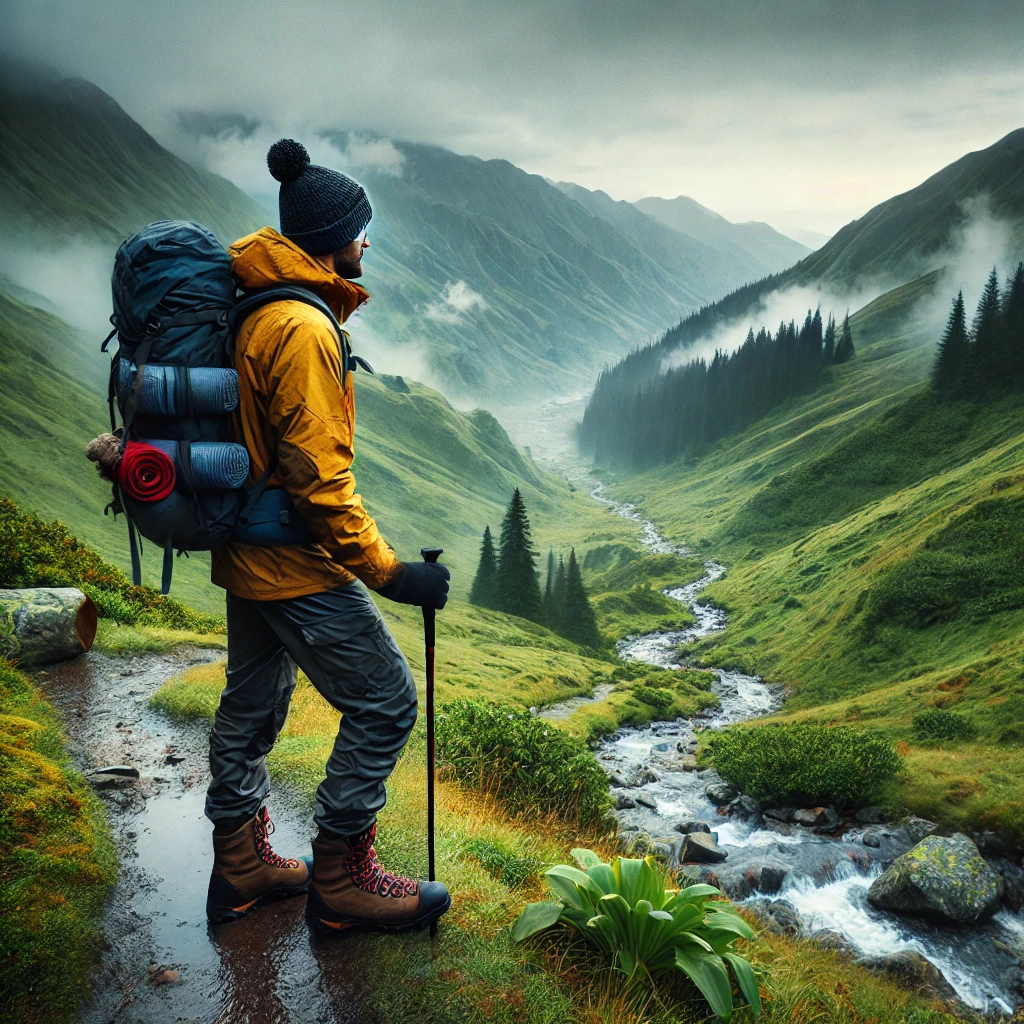
If you’re an avid hiker, you know the importance of staying warm and dry on the trail. The right hiking clothes can make or break your outdoor adventure.
Whether you’re tackling a mountain in unpredictable weather or simply enjoying a brisk fall hike, the right gear ensures you remain comfortable and safe.
In this guide, we’ll break down the essential clothing pieces that every hiker should have to stay warm and dry, no matter the conditions.
Ready to build your perfect hiking wardrobe?
Let’s dive in!
Why the Right Hiking Clothes Matter
Proper hiking clothes can be the difference between an enjoyable adventure and a miserable, potentially dangerous experience.
When the weather turns, or temperatures drop unexpectedly, staying dry and maintaining body heat is critical for both comfort and safety.
Hypothermia, cold stress, and excessive sweating due to improper clothing are all risks that can be avoided with the right gear.
From waterproof outer layers to insulation that traps heat, choosing the right hiking clothes is essential for any hike.
But beyond just warmth, these clothes should also be breathable, durable, and adaptable to changing weather conditions.
Key Features of Warm and Dry Hiking Clothes
When you’re out on the trail, being well-prepared with the right clothing can make a significant difference in your comfort and safety.
Here are the essential features to look for when selecting hiking clothes that will keep you warm and dry in various conditions:
1. Waterproof and Water-Resistant Materials
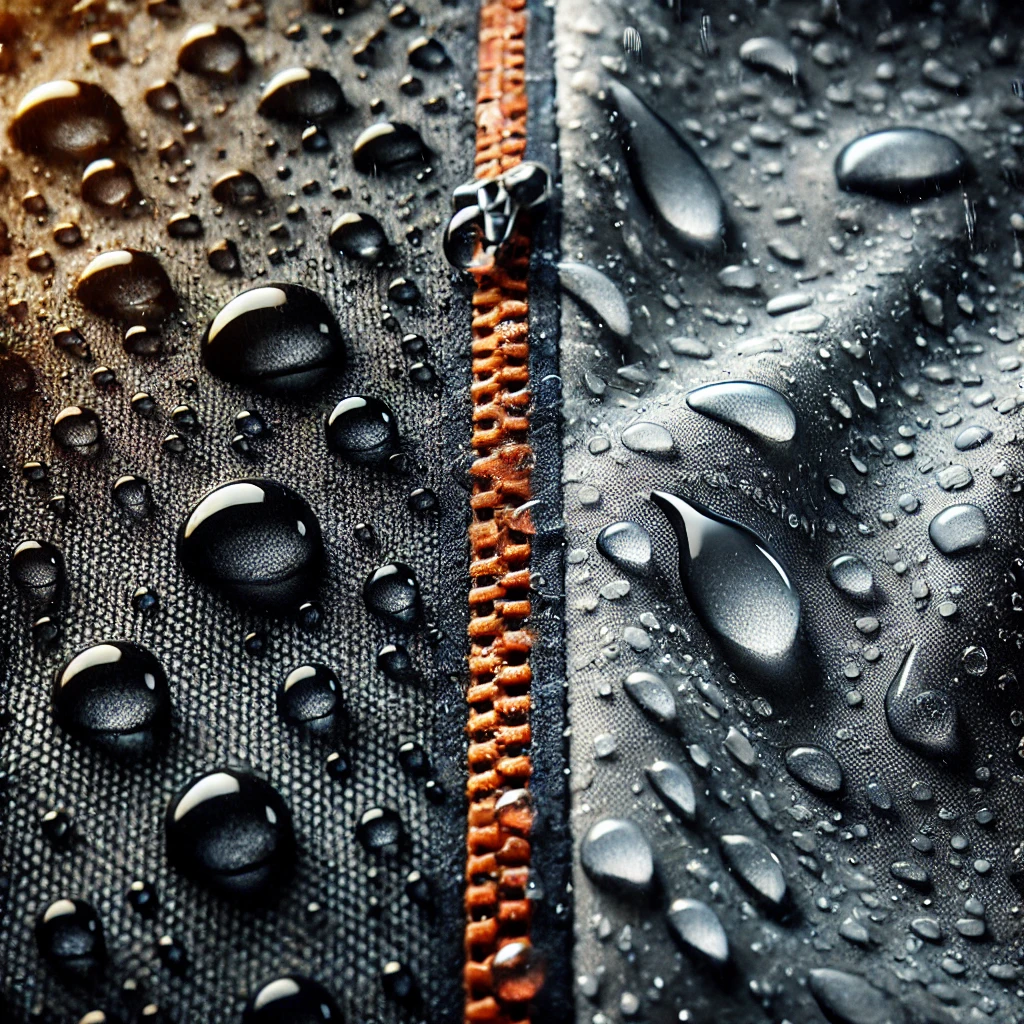
The most critical factor in staying dry during a hike is having gear made from waterproof or at least water-resistant materials.
This feature prevents external moisture (like rain, snow, or dew) from penetrating your clothing while also allowing sweat to escape, keeping you dry from the inside out.
- Waterproof Fabrics: Look for high-quality waterproof materials like Gore-Tex, eVent, or Pertex Shield. These are designed to provide full protection against water while still being breathable enough to prevent overheating. Jackets, pants, and boots with these materials offer the best protection for wet and snowy hikes.
- Water-Resistant vs. Waterproof: Water-resistant gear is treated with a Durable Water Repellent (DWR) coating, which can repel light rain or snow but won’t hold up against heavy downpours or prolonged exposure to moisture. While it’s often more breathable, it’s not as reliable for long or wet hikes. For serious adventures, always opt for waterproof gear over water-resistant.
- Example Gear: The Arc’teryx Beta LT Jacket is a prime example of a waterproof jacket that utilizes Gore-Tex, offering superior weather protection while maintaining breathability. Pair it with Salomon X Ultra 4 GTX Hiking Boots, which feature waterproof membranes to keep your feet dry on even the wettest trails.
2. Insulation: Down vs. Synthetic
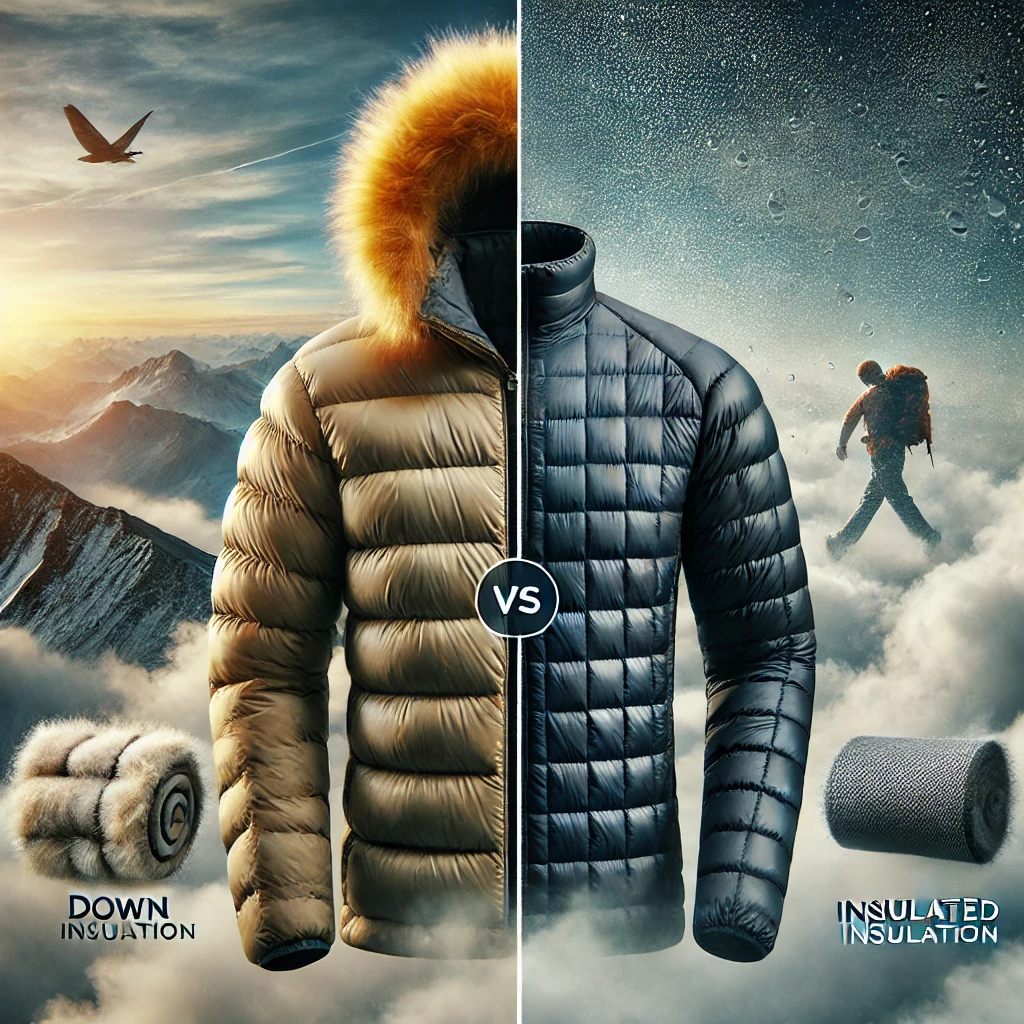
Staying warm while hiking in cold weather depends on proper insulation.
Whether you choose down or synthetic insulation will largely depend on the conditions you’ll face.
- Down Insulation: Down (usually from duck or goose feathers) is known for its superior warmth-to-weight ratio. It provides excellent insulation by trapping air, which helps retain body heat. The downside is that down loses its insulating ability when wet, making it less ideal for rainy conditions unless paired with a waterproof outer layer. Hydrophobic down is a newer innovation that retains its loft and warmth even when exposed to moisture, providing a good compromise.
- Synthetic Insulation: Synthetic materials like Primaloft and Thinsulate are designed to mimic the properties of down, but they retain their insulating abilities even when wet. While synthetic insulation is typically heavier than down, it’s better suited for wet environments and high-activity hikes where moisture from sweat or precipitation is a concern.
- Example Gear: For down, the Patagonia Down Sweater Jacket offers warmth without the weight, ideal for dry cold conditions. If you expect wet conditions, opt for the The North Face ThermoBall Eco Jacket, which uses synthetic insulation to provide warmth even in damp environments.
3. Layering System: Base, Mid, and Outer Layers
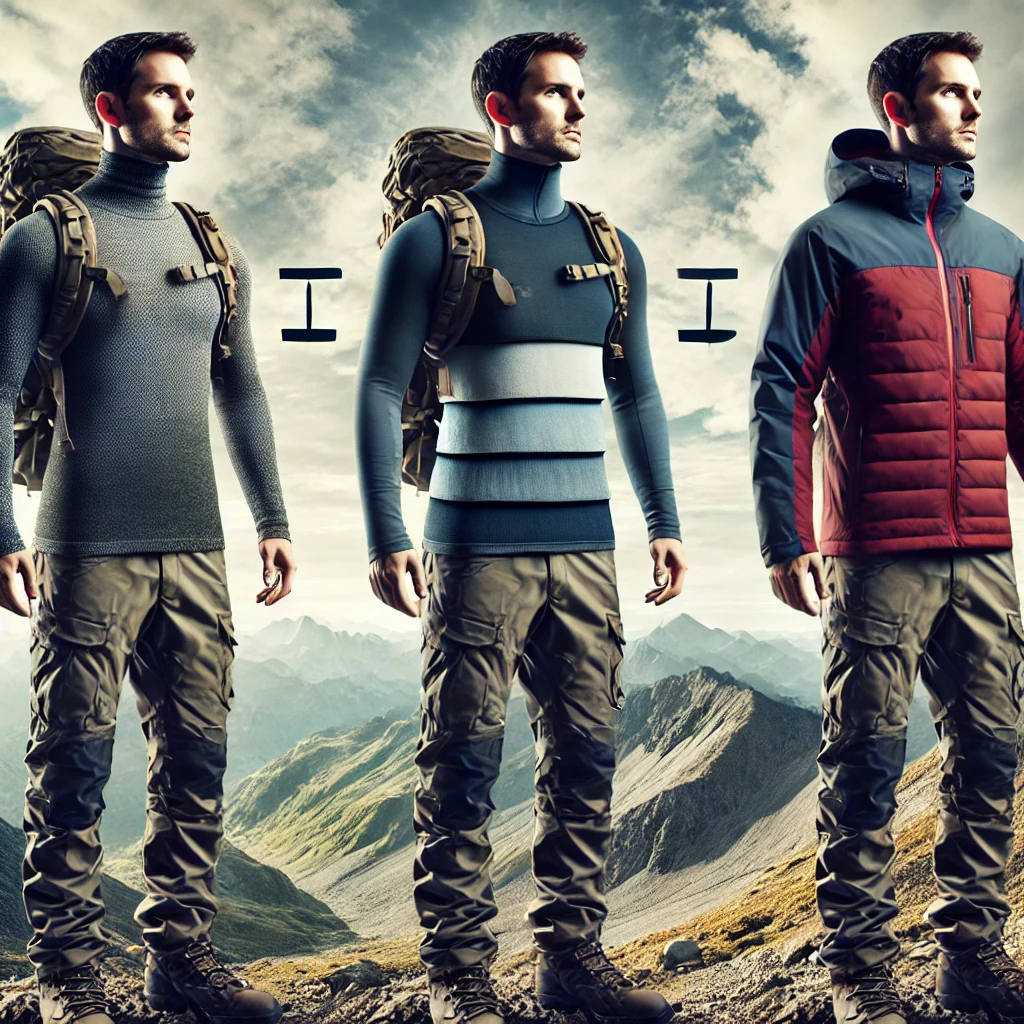
The key to staying warm and dry on a hike is layering your clothing appropriately.
A well-constructed layering system allows you to adapt to changing temperatures and conditions without overheating or getting cold.
- Base Layer: This is your first layer of defense, worn directly against your skin. The primary job of the base layer is to wick sweat away from your body, keeping you dry. Materials like merino wool and synthetic fabrics like polyester are ideal because they dry quickly and regulate temperature. Avoid cotton as it retains moisture and can leave you feeling cold and clammy.
- Mid-Layer: The mid-layer provides insulation, helping trap body heat. Fleece and down jackets are common mid-layers, and they can be easily added or removed depending on the weather. Fleece is lightweight, breathable, and dries quickly, making it a great mid-layer option for active hikers. Down and synthetic insulated jackets offer more warmth but may be less breathable during high-exertion hikes.
- Outer Layer (Shell): The outer layer serves as your protection from wind, rain, and snow. A waterproof, windproof shell is essential for keeping the elements out while allowing sweat and heat to escape. This prevents you from getting too warm and sweaty inside your gear while also protecting you from external moisture and wind chill.
- Example Gear: Start with a Smartwool Merino 250 Baselayer for moisture-wicking comfort, layer with the Patagonia R1 Fleece for warmth, and top it off with the Marmot Minimalist Jacket, a lightweight Gore-Tex shell that provides waterproof and windproof protection.
4. Breathability: Prevent Overheating
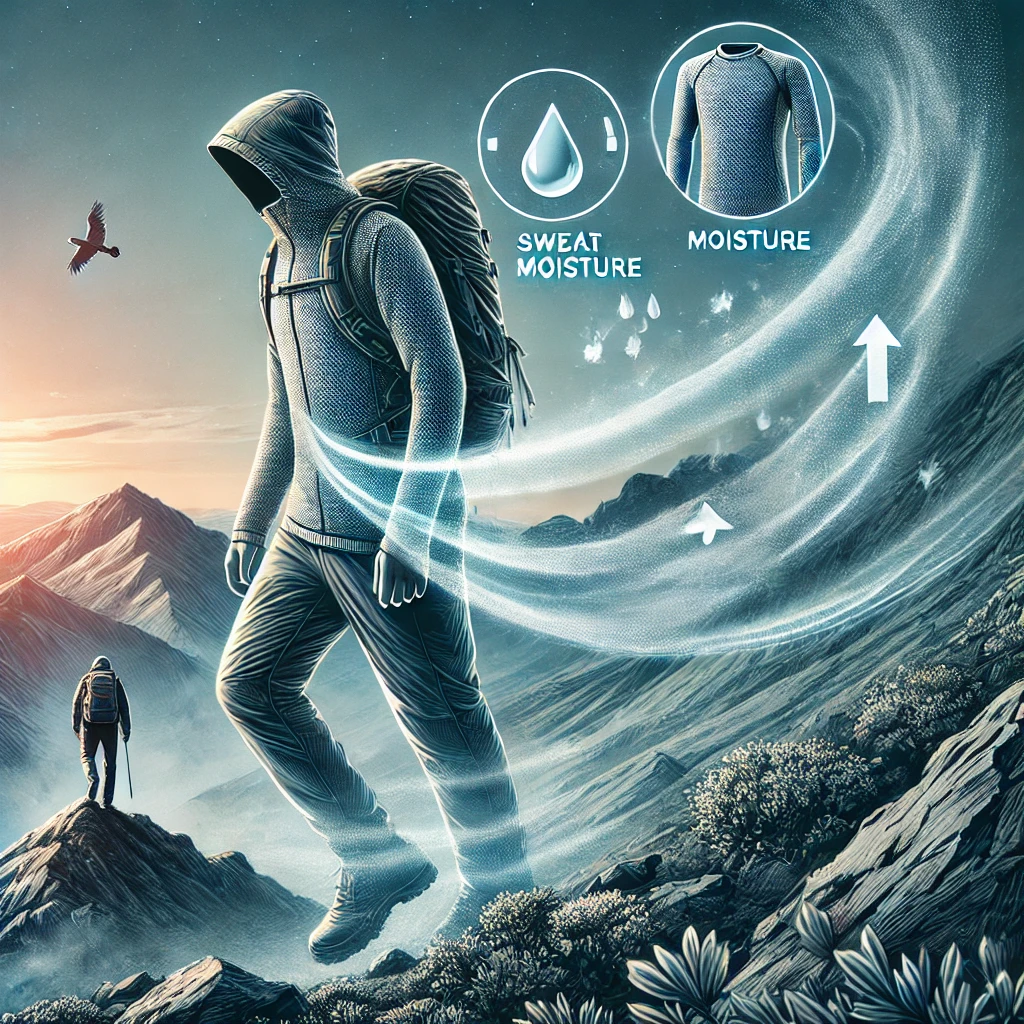
While staying warm is essential, it’s equally important to prevent overheating.
Hiking is an active sport, and as your body temperature rises, you’ll start sweating.
Clothes that don’t allow sweat to escape can lead to moisture buildup, which will eventually make you feel cold when you stop moving.
- Breathable Fabrics: Look for clothes made from breathable materials such as merino wool, fleece, and synthetic layers that wick away moisture. For outer shells, choose waterproof fabrics with breathable membranes, such as Gore-Tex, which allows vapor to escape while preventing water from coming in.
- Ventilation Options: Many hiking jackets and pants come with pit zips, core vents, or adjustable cuffs and hems, which allow you to regulate airflow and prevent overheating. These features are crucial for maintaining the balance between staying dry from external moisture and managing internal heat.
- Example Gear: The Outdoor Research Helium II Jacket is a great example of a lightweight, breathable shell that still offers solid waterproofing. For high-intensity hikes, consider a pair of Fjällräven Keb Trousers, which feature ventilation zippers along the legs to dump excess heat.
5. Durability: Designed to Last

Hiking clothes endure a lot of wear and tear, from rugged terrain to abrasive rocks and brush.
Durability is an essential feature of quality hiking gear, ensuring that it withstands harsh conditions and frequent use without tearing or wearing out.
- Reinforced Fabrics: Look for materials with reinforced stitching or abrasion-resistant panels in high-wear areas, such as knees, elbows, and shoulders. Durable fabrics like Cordura or ripstop nylon provide extra strength without adding significant weight.
- Longevity vs. Weight: While ultralight gear is appealing for fast hikers, keep in mind that extremely light materials can sometimes compromise durability. Strike a balance between weight and toughness, especially if you’re venturing into areas with rugged terrain or unpredictable conditions.
- Example Gear: The Fjällräven Vidda Pro Trousers are known for their durable, abrasion-resistant fabric, making them perfect for rugged hikes. Pair them with the Black Diamond First Light Hybrid Hoody, which features reinforced panels in key areas while still providing warmth and flexibility.
6. Windproofing: Block the Cold Wind
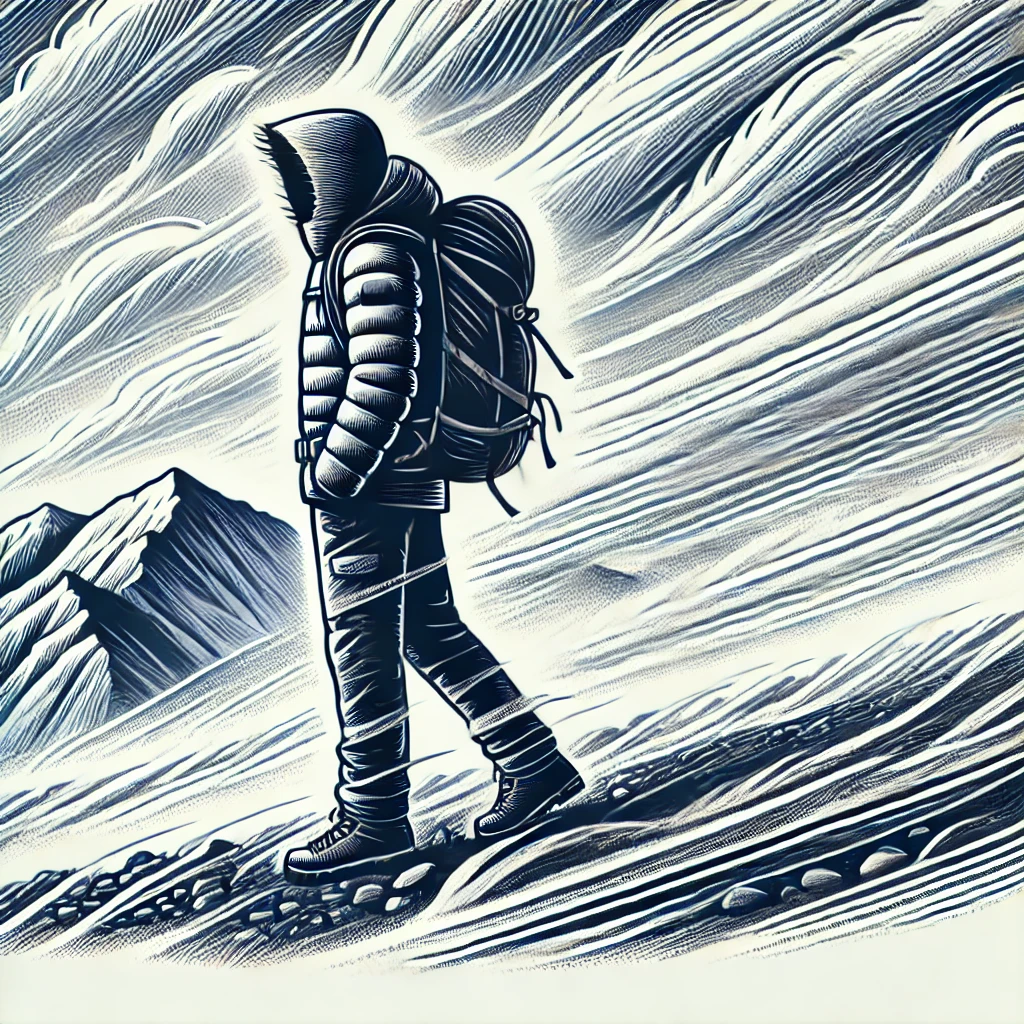
Wind can significantly lower your body temperature, even on otherwise mild days.
A windproof outer layer will shield you from cold gusts, preventing wind chill from sapping your warmth.
- Windproof Materials: Many high-quality shells, especially those made from Gore-Tex Windstopper fabric or similar materials, are designed to block out the wind entirely. This helps preserve your body heat and adds an extra layer of protection against the cold.
- Multifunctional Layers: Some jackets combine waterproof and windproof features, making them an all-in-one solution for unpredictable weather. This is particularly useful for hikers in alpine or exposed environments, where strong winds can hit unexpectedly.
- Example Gear: The Outdoor Research Ferrosi Hooded Jacket is windproof, breathable, and lightweight, making it an ideal choice for high-intensity hikes where wind protection is crucial.
By focusing on these essential features—waterproofing, insulation, layering, breathability, durability, and windproofing—you’ll be well-equipped to tackle any hike, no matter how cold or wet the conditions.
Choosing the right combination of these features ensures you stay warm and dry while hiking, allowing you to focus on enjoying the trail rather than battling the elements.
The Must-Have List of Hiking Clothes to Keep You Warm and Dry
When it comes to staying warm and dry on your hikes, having the right gear is essential.
Below is a breakdown of the must-have hiking clothes for every adventurer.
These items are designed to keep you comfortable in a variety of weather conditions by managing moisture, insulating body heat, and protecting you from the elements.
Each category includes both recommended products and budget-friendly options, ensuring you can find the perfect gear for your needs.
1. Base Layer: Stay Dry by Wicking Away Moisture

Your base layer is crucial for keeping your skin dry by wicking away sweat.
Moisture on the skin can quickly lead to chills when temperatures drop, so it’s essential to choose a fabric that dries quickly and retains warmth, even when damp.
- Material: Merino wool and synthetic fabrics like polyester are the best choices for base layers. Both materials are breathable, moisture-wicking, and quick-drying, ensuring you stay dry and comfortable throughout your hike. Avoid cotton at all costs, as it absorbs moisture and stays wet, which can lead to discomfort and cold.
- Recommended Product:
Smartwool Merino 250 Baselayer Top
This top is made from 100% merino wool, which naturally regulates body temperature, wicks moisture, and is odor-resistant. It’s perfect for cold hikes, offering warmth without overheating. - Budget-Friendly Option:
TSLA Thermal Long Sleeve Baselayer
A synthetic, affordable option that provides excellent moisture management and thermal insulation. It’s lightweight and ideal for layering in colder conditions. - Why It’s Important: A base layer wicks sweat away from your body, keeping you dry and preventing the cold from setting in. Without a proper base layer, even a mild hike can become uncomfortable, especially when temperatures fluctuate.
2. Mid-Layer: Trap the Heat
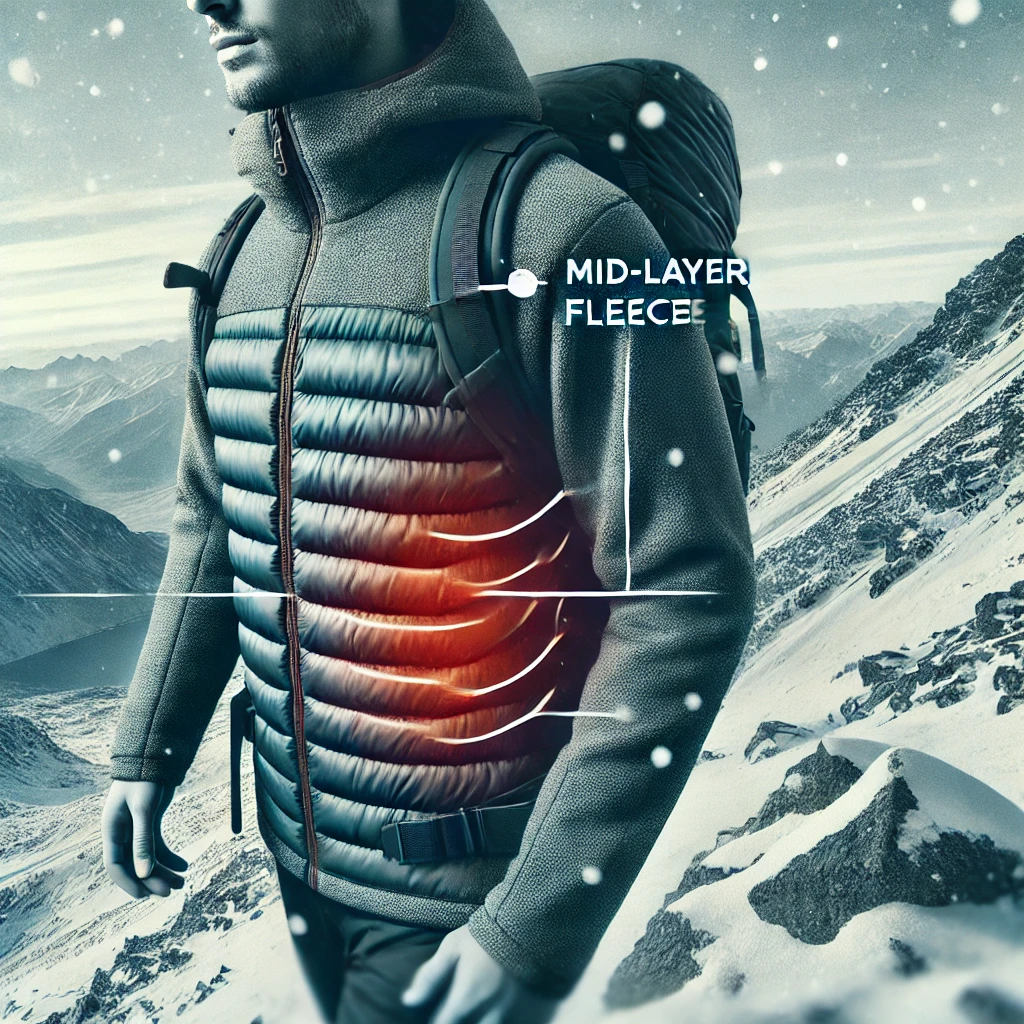
The mid-layer is your primary source of insulation.
Its job is to trap your body heat while still allowing sweat to escape from your base layer.
Fleece and down are popular materials for mid-layers, as they provide excellent warmth without adding too much bulk or weight.
- Material: Fleece, down, or synthetic insulation like Primaloft. Fleece is breathable, lightweight, and dries quickly, making it perfect for active hikes. Down provides superior warmth in dry conditions but can lose its insulating properties when wet. For wet environments, synthetic insulation is a better option.
- Recommended Product:
Patagonia Men’s Better Sweater Fleece Jacket
A versatile fleece jacket that offers warmth without bulk. The soft, breathable fabric keeps you comfortable during brisk hikes and can be easily layered with other clothing. - Budget-Friendly Option:
Columbia Steens Mountain Fleece
An affordable, durable fleece jacket that offers excellent warmth in cool conditions. It’s a great mid-layer option for both beginners and experienced hikers. - Why It’s Important: Your mid-layer traps body heat, providing essential warmth, especially when temperatures drop. It also allows you to regulate your temperature easily—simply add or remove layers as needed.
3. Outer Layer (Shell): Stay Dry with Waterproof Protection
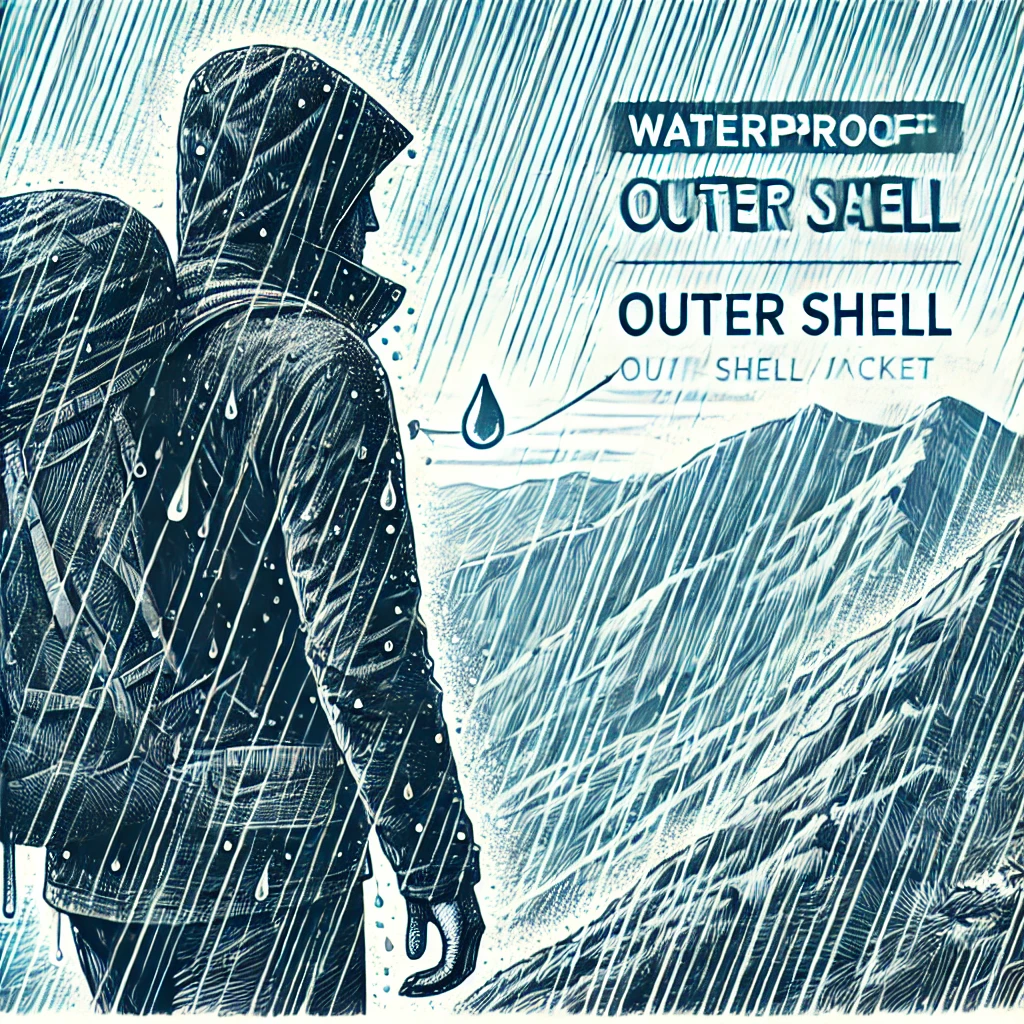
Your outer layer is your first line of defense against rain, snow, and wind.
This layer should be waterproof, windproof, and breathable to protect you from the elements while allowing your sweat to escape.
A high-quality outer shell ensures that no moisture can penetrate, keeping you dry and comfortable throughout your hike.
- Material: Look for waterproof fabrics like Gore-Tex, eVent, or Pertex Shield, which offer a good balance between waterproofing and breathability. Many jackets come with additional features like pit zips for ventilation, adjustable hoods, and reinforced areas for durability.
- Recommended Product:
Arc’teryx Zeta SL Jacket
A lightweight, fully waterproof jacket with Gore-Tex protection, perfect for hikers who need a breathable, durable shell for wet and windy conditions. - Budget-Friendly Option:
Marmot PreCip Eco Jacket
A reliable and affordable waterproof jacket made with Marmot’s NanoPro technology, offering excellent breathability and weather protection at a fraction of the price. - Why It’s Important: The outer layer ensures that you stay dry and protected from wind and rain. Without a waterproof shell, even light drizzle can soak your clothes, leaving you cold, wet, and miserable.
4. Hiking Pants: Waterproof and Insulated
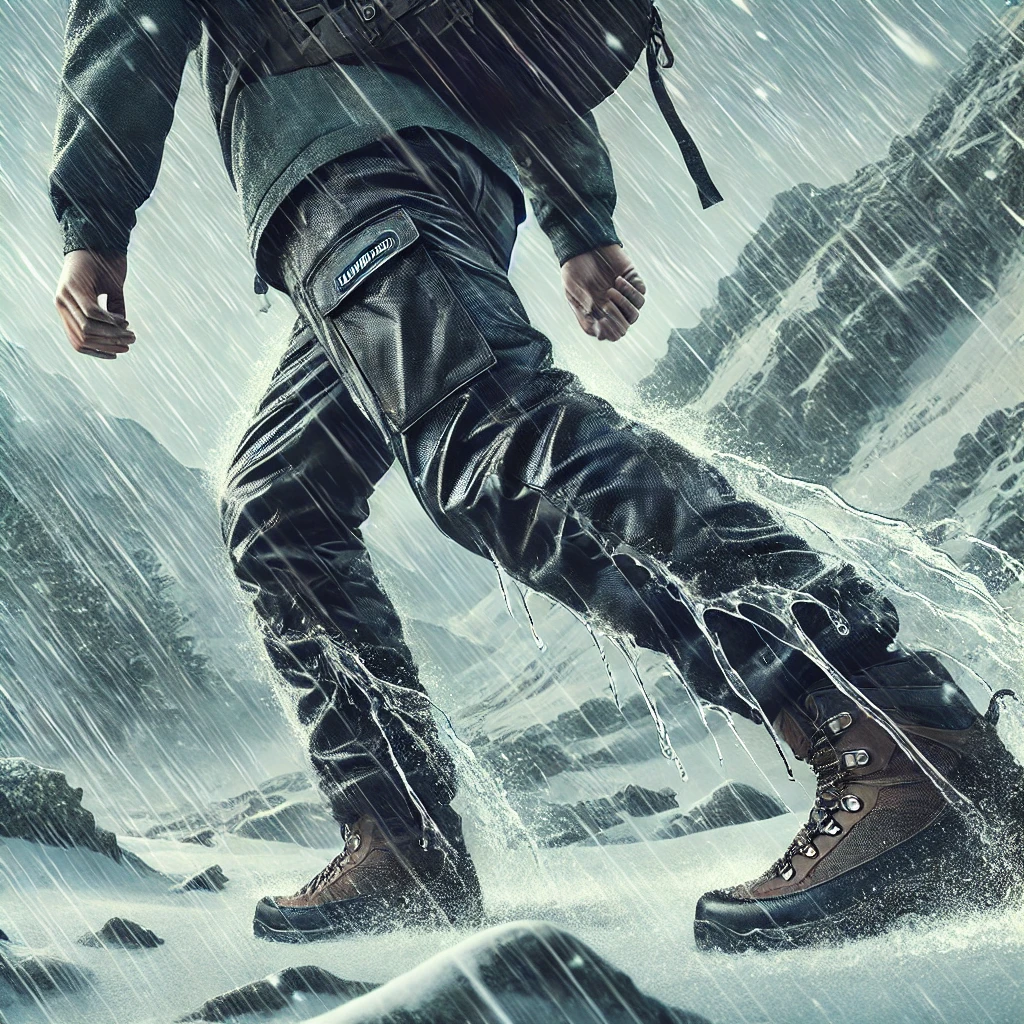
Your legs need just as much protection from the elements as your upper body.
In wet or cold conditions, waterproof and insulated hiking pants are essential for keeping your lower body warm and dry.
Look for pants made from durable materials with waterproofing technology and adjustable features for comfort.
- Material: Waterproof fabrics like Gore-Tex or DWR-coated nylon. Some hiking pants also come with a fleece lining or synthetic insulation to add extra warmth in colder climates.
- Recommended Product:
The North Face Freedom Insulated Pants
These pants feature waterproof fabric with built-in insulation, perfect for cold, wet conditions. The articulated knees and adjustable waist ensure a comfortable fit for all-day wear. - Budget-Friendly Option:
Columbia Bugaboo II Pant
These affordable, waterproof pants offer excellent protection against rain and snow. They’re lightweight, durable, and ideal for hikers on a budget. - Why It’s Important: Hiking pants that are waterproof and insulated provide essential protection from rain, snow, and cold winds, keeping your legs dry and warm on the trail. Without the right pants, your legs can quickly become cold and stiff, which can lead to discomfort and even hypothermia.
5. Hats, Gloves, and Socks: Don’t Forget the Extremities
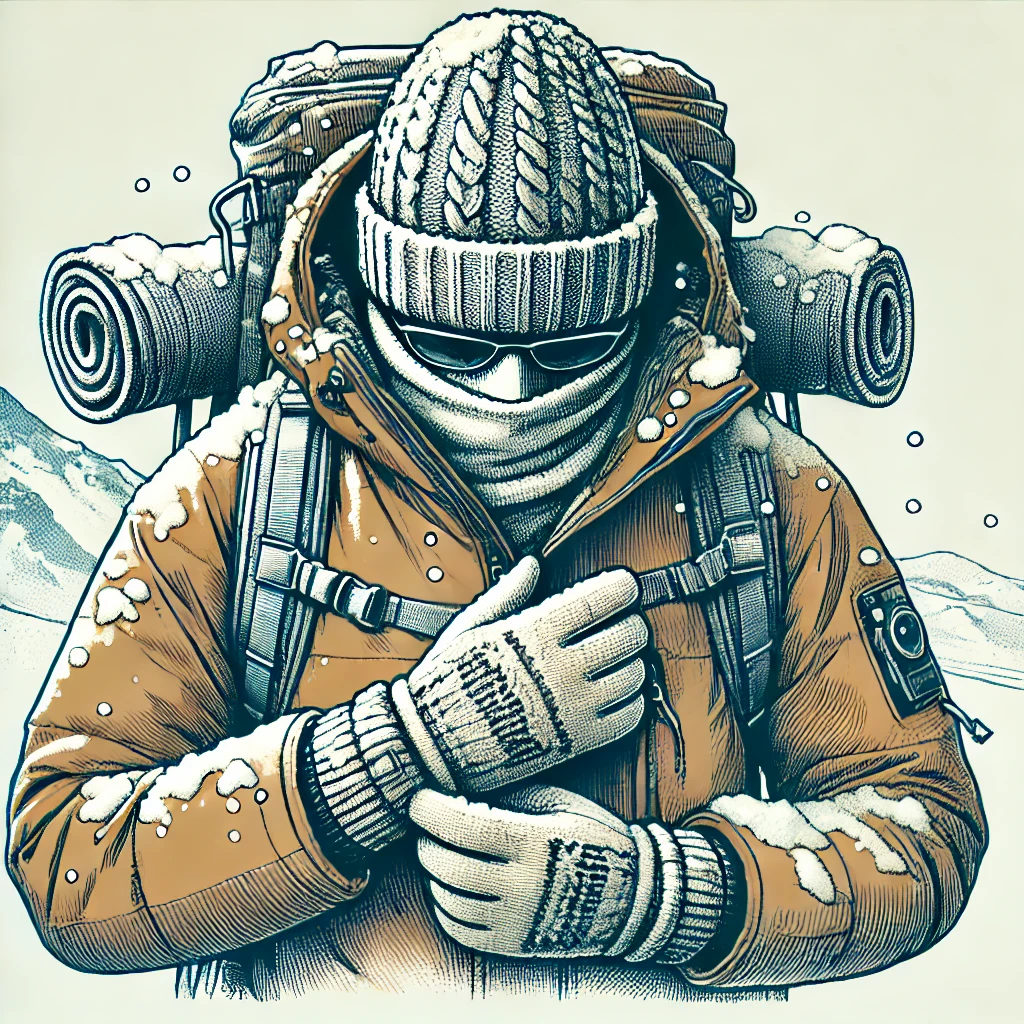
Your head, hands, and feet are particularly vulnerable to cold weather.
To keep these areas warm, you’ll need a good hat, insulated gloves, and moisture-wicking socks.
These accessories are critical for retaining heat and protecting you from frostbite in freezing temperatures.
- Material: Merino wool or synthetic materials like polyester for socks and gloves. For hats, wool or fleece works best for retaining warmth. Ensure all accessories are moisture-wicking and fast-drying.
- Recommended Product:
Smartwool Merino Wool Hiking Socks
These socks are made from merino wool, which keeps your feet warm and dry by wicking away moisture and providing insulation, even when wet. - Budget-Friendly Option:
Carhartt Insulated Work Gloves
Durable, insulated gloves designed to keep your hands warm in cold conditions. Perfect for hikers who need affordable, heavy-duty protection. - Why It’s Important: Proper insulation for your head, hands, and feet prevents heat loss in cold conditions. Neglecting these extremities can lead to frostbite or other cold-related issues, so make sure you’re equipped with quality accessories.
6. Footwear: Waterproof Hiking Boots

Keeping your feet warm and dry is one of the most important aspects of any hike, especially in cold or wet conditions.
Proper hiking boots should be waterproof, provide ample insulation, and offer good traction to handle various terrains.
- Material: Waterproof materials like Gore-Tex or eVent are ideal for hiking boots. Look for boots with good ankle support and durable outsoles for traction on rocky or slippery terrain.
- Recommended Product:
Salomon X Ultra 4 GTX Hiking Boots
These boots feature Gore-Tex waterproofing and offer excellent traction and support for any terrain. They are lightweight, durable, and perfect for both wet and dry conditions. - Budget-Friendly Option:
Columbia Newton Ridge Plus Waterproof Amped Hiking Boots
These affordable waterproof boots provide excellent comfort, durability, and grip, making them a great option for beginner hikers or those on a budget. - Why It’s Important: Without proper waterproof boots, your feet can become soaked, leading to blisters, discomfort, and even hypothermia in colder conditions. Good hiking boots protect your feet from the elements while providing the stability needed for challenging terrain.
By ensuring that you have the proper base layers, mid-layers, outer layers, pants, accessories, and footwear, you’ll be well-equipped to handle whatever the trail throws at you.
Each item plays a critical role in keeping you warm, dry, and comfortable, so invest wisely in your gear and enjoy the adventure!
Expert Tips for Staying Warm and Dry on the Trail
- Tip 1: Always pack an extra layer—weather can change unexpectedly, and it’s better to have too much than too little.
- Tip 2: Avoid cotton clothing, which absorbs moisture and can make you feel cold and uncomfortable.
- Tip 3: Opt for high-quality materials like merino wool and Gore-Tex for the best results in extreme weather.
Recommended Brands and Products for Warm and Dry Hiking Clothes
- The North Face: Known for durable, weather-resistant gear.
- Patagonia: Sustainable, high-quality hiking clothes for all weather conditions.
- Columbia: A reliable brand offering budget-friendly, performance-driven outdoor apparel.
- Smartwool: Ideal for wool socks and base layers that keep you warm while wicking away moisture.
Where to Buy Your Hiking Clothes
Many of the products mentioned are available on Amazon.
Amazon offers competitive pricing and often includes customer reviews that can help guide your purchasing decision.
Additionally, outdoor retailers such as REI and Backcountry offer premium selections with expert guidance, though often at a higher price point.
Conclusion
Staying warm and dry on the trail is crucial for a successful and enjoyable hiking experience.
By investing in the right hiking clothes, you’ll not only stay comfortable but also protect yourself from potential risks like hypothermia and cold stress.
Don’t forget to layer properly, avoid cotton, and choose waterproof, breathable fabrics for your outer shell.
So, are you ready to hit the trails in comfort?
Check out the products recommended in this post and gear up for your next adventure!
If you found this guide helpful, be sure to share it with your hiking buddies or drop a comment below to let us know your must-have hiking clothes.
And don’t forget to subscribe to our newsletter for more hiking tips, gear recommendations, and outdoor adventure inspiration!
Note: This blog post contains affiliate links, which means I may earn a small commission at no extra cost to you if you purchase through these links. That said, I only recommend items that are of the highest value to you.
Thank you for supporting my site!
FAQ
- How should I layer for cold-weather hiking?
- Start with a moisture-wicking base layer, add an insulating mid-layer (like fleece or down), and finish with a waterproof, windproof outer shell.
- Are there budget-friendly options for hiking gear?
- Absolutely! Many great brands, such as Columbia and Marmot, offer affordable yet high-quality gear that won’t break the bank.
- What’s the difference between water-resistant and waterproof gear?
- Waterproof gear completely blocks moisture, while water-resistant gear can repel light rain but may not hold up in heavy downpours. Always opt for waterproof when hiking in unpredictable weather.
Top 10 Hiking Pants Men Swear By for Comfort and Durability
Top 10 Hiking Sneakers: An In-Depth Rating and Review
As an Amazon Associate I earn from qualifying purchases.

